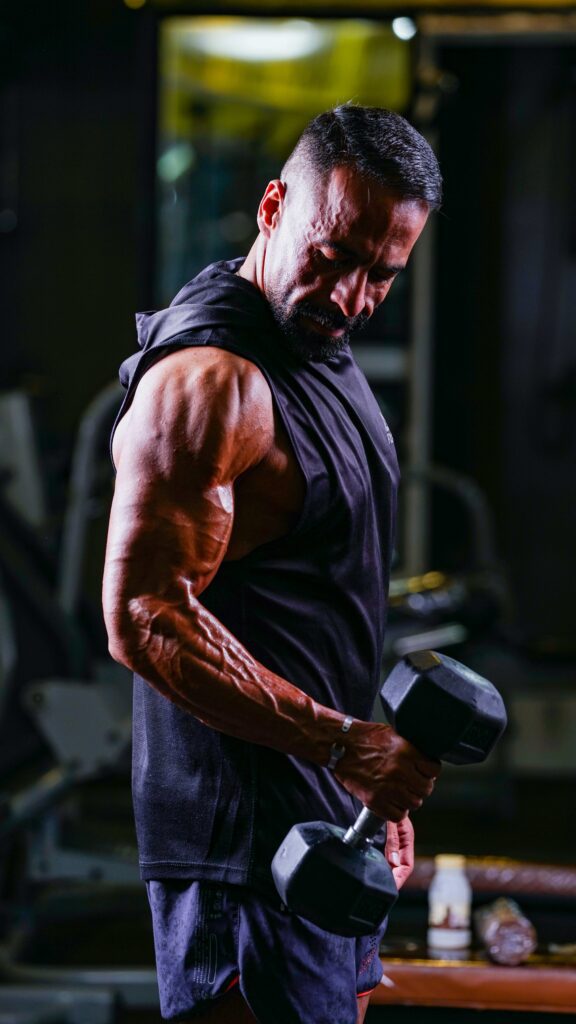For most guys, walking into the gym is akin to a tour of the Pridelands from Lion King. The fluorescent light shines across the squat racks and machines, free weights glistening with the sheen of another human’s sweat. But there, along the back wall, lies the land one must never go if they want to see gains: the cardio section. Bikes are a no-go, while treadmills are to be avoided at all costs. Or at least, that’s what most have been led to believe if they want to get swole for the summer. But it turns out we might have been wrong about cardio all this time, as new research suggests it can actually encourage muscle growth if done ahead of weight lifting.
According to a new study published in Scientific Reports, 20 minutes of intense cycling right before an upper-body weight routine alters the inner workings of muscles, priming them to change and grow more than with lifting alone. The study involved eight physically active men, with the findings serving as a practical guide about how one might structure a gym workout for maximum benefit, particularly when it comes to muscle growth.
The revelation comes after years of debate whereby scientists and trainers alike have looked to better understand how to mix cardio and resistance exercises. Some small studies suggest combining the two might up the likely gains from each, which others have suggested aerobic workouts beforehand could even reduce strength improvements from lifting. Most authors from these studies speculate that molecular changes within muscles, caused by cycling or running, end up hindering some of the other desirable outcomes from lifting due to an effect known as exercise interference. Muscle fatigue also comes into play, as most studies that were conducted and paired cardio and resistance focused solely on lower bodies.

How To Torch 1000 Calories in Your Lunch Break

Lifting Weights Cuts Your Risk Of Early Death By 46%
Marcus Moberg, a professor at the Swedish School of Sport and Health Sciences in Stockholm, took a different approach. In the study, Moberg ensured the two types of exercise targeted completely separate groups of muscles, with legs during the cycling and arms during the weight routine. After recruiting eight active adult men, participants were assessed for their current aerobic fitness and strength. They then familiarised themselves with the lab’s work equipment and, on a separate visit, completed a two-part workout. It began with an intense interval cycling where they pedalled hard for four minutes, rested for three, and then repeated the sequence four times. After a few minutes of rest, they moved onto upper-body weight machines that worked the arm and shoulder muscles.
On another lab visit, they completed the same weight routine but without cycling prior. Researchers drew blood and took tiny tissue samples from the men’s tricep muscles before, immediately after, 90 minutes later and then three hours after each workout. In examining the men’s blood and muscle samples, the scientists looked for how the muscles were responding to workouts, with special emphasis on proteins and markers of gene activity.
They found that after the solo weight training session, muscles were teeming with proteins and genetic markers known to help initiate muscle growth. But these same substances also abounded after the workout that included cycling prior, but were joined by other proteins and gene activity too, that’s associated with improved endurance. As the New York Times notes, “In effect, after the dual workout, the men’s muscles seemed primed to increase in both size and stamina, with no evidence that cycling had interfered, at a molecular level, with lifting. Instead, the aerobic exercise appeared to have broadened and intensified the expected benefits from weight training.”
As Moberg added, “The most fascinating finding is that some biochemical factors evoked by the leg endurance exercise entered the bloodstream and were then able to influence processes in a completely different group of muscles, and in a way that seems to be beneficial for the training adaptations in the arms. It is almost like the endurance exercise performed by the legs was being transferred to some degree to the arms.”
















